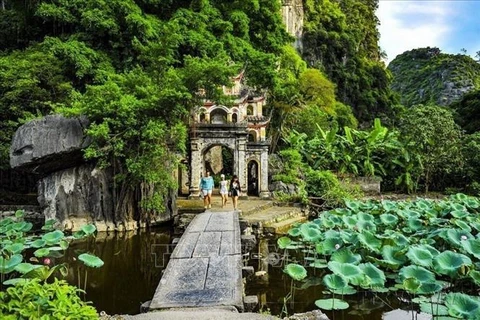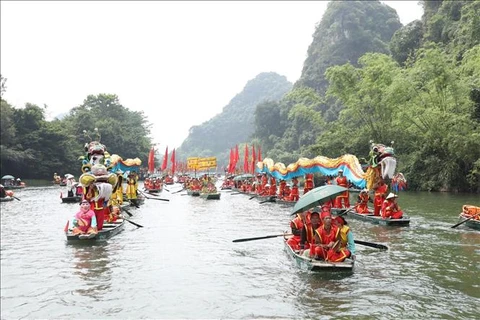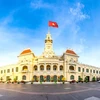
Ninh Binh (VNA) - To promote the value of cultural heritage, the northern province of Ninh Binh, which is home to Trang An Landscape Complex – a UNESCO-recognised World Cultural and Natural Heritage Site, has been implementing strategic solutions to harmoniously solve the relationship between restoration and conservation and sustainable development.
The province has had many projects, programmes, and plans for both tangible and intangible cultural heritage restoration and conservation that have been implemented effectively, thus raising community awareness in preserving and promoting local heritage.
Boasting rich cultural heritage, Ninh Binh has consistently implemented for decades the goal of sustainable development, and harmonising the relationship between culture, economy, the environment and society.
The provincial Party Committee’s Resolution No. 03-NQ/TU on tourism development to 2010, dated December 18, 2001, was the province's first thematic resolution on tourism development which determined the strategic direction of economic development from "brown" to "green", and shifted from the construction material industry to tourism development.
Determining culture as the most important resource and tourism as an outstanding strength, in recent times, Ninh Binh has continuously invested in repairing, restoring, preserving and promoting the value of cultural heritage. Since 2021, it has spent more than 136 billion VND (5.35 million USD) on restoring and promoting the value of relic sites, thus helping to increase cultural and educational values on the tradition and history, and attracting more visitors.
Attention has also been paid to intangible cultural heritage such as Hoa Lu Festival, Xam singing (blind wanderers' music), practices related to the Vietnamese beliefs in the Mother Goddesses in Three Realms, and Rang Thuong singing of the Muong ethnic people.
In particular, based on the value of heritage, many new and unique products have been built associated with tourist sites, destinations and tours, helping Ninh Binh become an attractive destination to both domestic and foreign tourists.
Last year, the province served more than 6.5 million visitors and earn over 6.5 trillion VND (255.7 million USD), doubling that of 2022. In the first four months of this year, it drew over 4.9 million holiday-makers and pocketed more than 4.6 trillion VND from tourism services, according to the provincial Statistics Office.
Tong Quang Thin, Vice Chairman of the provincial People's Committee, said that in the coming time, the locality will work to develop tourism into a spearhead economic sector so as to become a major tourism centre of the whole country and the region.
To that end, Ninh Binh will innovate the way of thinking about restoring and preserving cultural heritage associated with socio-economic development; build a strategy for developing the cultural industry with a focus and roadmap on a professional and modern direction, and promoting local advantages in accordance with the basic rules of the market economy.
In addition, Secretary of the provincial Party Committee Doan Minh Huan also affirmed the importance of building a millennium heritage city on a time axis of more than 1,000 years associated with the three dynasties of Dinh, Early Le, and Le of the Dai Co Viet State - the first centralised feudal state in Vietnam's history./.






















